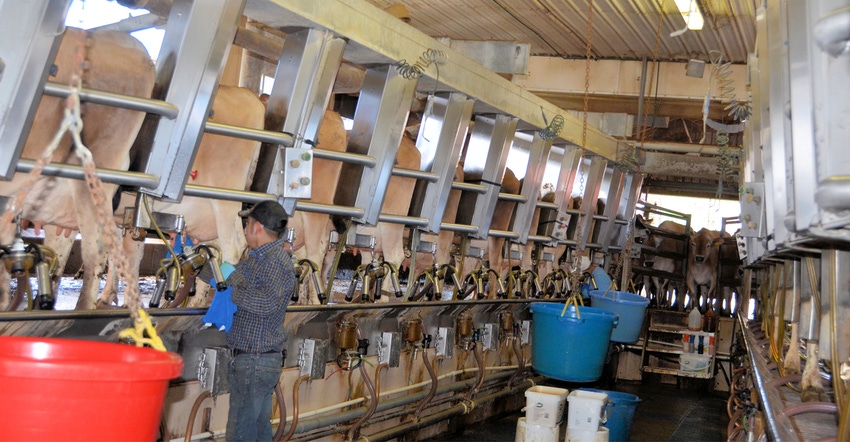October 25, 2018

By Gary Latta
New York, Pennsylvania and Vermont are among the top 23 dairy states in the country. All three states showed a decrease in cow numbers for September, while New York and Vermont showed improvement in cow output.
Only New York was up in total monthly milk production for September at 0.8%. Other large dairy states such as California, Texas, Wisconsin and Minnesota all showed sizable increases in September milk production, primarily from increases in output per cow.
State of trade
Many things have happened over the past few months that will affect dairy in the Northeast and around the globe. Most likely at the top of anyone’s list is the new trilateral trade agreement between the U.S., Mexico and Canada.
While some are skeptical over how much this new deal will benefit the U.S., it appears most industry leaders think the deal is a win for dairy. The agreement must still be ratified by all three countries before it can go into effect, and senior administration officials believe this will take place by the end of November.
Striking a deal with Mexico was very important. Mexico is by far the largest market for U.S. dairy exports. In 2017, Mexico imported $1.31 billion worth of U.S. dairy products. Cheese alone was $400 million in export sales. By comparison, Canada imported $637 million worth of U.S. dairy products in 2017, and China was our third-largest international dairy market with $576 million of U.S. products. Chinese tariffs remain in place and continue to dampen sales there.
For many, the trade agreement was a victory for the dairy industry. After 14 months of intense and often heated negotiations, Canada agreed to allow 3.59% of tariff-free U.S. dairy products into their $16 billion domestic market and eliminate their Class 7 pricing scheme. The original terms of the Trans-Pacific-Partnership allowed for a 3.2% share, so 3.59% is a small increase. While it may not sound like much, some Canadian dairy analysts think the portion of U.S. access to their dairy market will climb from 10% to 18% in seven years under the new terms.
Another victory was forcing Canada to eliminate its Class 7 pricing mechanism. In early 2017, Canada suddenly created a new Class 7 that essentially eliminated competition on protein concentrates, whole milk powder and skim powder used to make yogurt, cheese, infant formula, and other products. Pricing will now be at U.S. levels for these products.
Perhaps even more significant is the requirement that Canada factor in an export charge on dry specialty products, which should help the U.S. in securing future global opportunities. Previously, Canada used its Class 7 pricing to increase exports while U.S. exports came to a swift halt. This helped Canadian milk production while dumping more product on the international market.
Many dairy producers and ag leaders have mixed feelings on the agreement. As expected, most Canadians are unhappy with it while U.S. leaders are cautiously optimistic, including agricultural leaders in the Northeast. New York has a couple of plants that manufacture dry specialty ingredients. These plants were negatively affected by Canada’s Class 7 pricing. The hope is that this new agreement will help re-open some new overseas markets.
Pennsylvania exports nearly 60% of its agricultural products, over $1.43 billion a year, to Canada and Mexico. Time will tell us just how meaningful this increased access to the Canadian market will be for dairy farmers.
Too much milk, still
Burdensome milk supplies continue to weigh heavily on prices. If industry observers were amazed at the 1.3% growth in milk supply for August, they must have been scratching their heads at the 1.5% supply increase in September.
USDA made special note of the fact that milk per cow usually drops seasonally between July and August. Seasonal milk-per-cow declines have averaged 1.2% over the past 20 years. This year, however, the decline was a mere 0.5%.
Overall, milk production continues to grow due to better cow output. Cow numbers have slowly been dropping over the past several months while per-cow output and productivity climbs in the top 23 milk-producing states. Some experts attribute this to favorable feed prices.
In its October report, USDA revealed that September production per cow averaged 1,880 pounds, a 30-pound increase over September 2017. This was the highest production per cow achieved for the month of September since 2003. The number of cows in September in the top 23 states was 8.72 million head, a decrease of 13,000 head from the previous year.
Slightly higher prices in 2019
USDA has adjusted its milk production forecasts for 2018 and 2019 and has increased its 2019 forecast for cow numbers.
USDA’s butter and whey price forecasts for 2018 and 2019 were higher this month due to demand strength. Cheese prices dropped due to large supplies in storage, and nonfat dry milk was left unchanged. Because of these adjustments, the Class III price estimate for 2018 was lowered, but the Class III for 2019 was raised because higher whey prices are expected to offset slightly softer cheese prices.
USDA raised its estimated Class IV price for both 2018 and 2019 due to higher nonfat dry milk and butter prices. These adjustments result in a 2018 all-milk price forecast that is unchanged at $16.35-$16.45. The 2019 all-milk price is higher and is now in the range of $16.85-$17.75.
It looks like 2019 milk prices will be like 2017 when the all-milk price was $17.65.
Mixed results overseas
Favorable weather in New Zealand has helped grow milk production there by nearly 5.5%, but it’s beginning to weigh on prices. Australian milk production is down 3.4% because of drought.
The EU-28 countries have experienced very hot and dry conditions and expect milk production to climb by only 0.8% for the year.
Latta is the director of industry relations with Northeast Dairy Foods Association in North Syracuse, N.Y
You May Also Like




